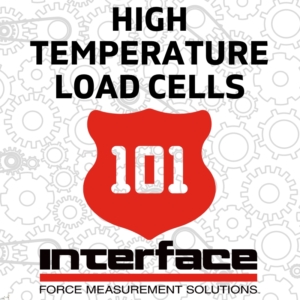High Temperature Load Cells 101
 The temperature rating of a strain gage type load cell is primarily dependent upon the materials selected for its construction. While the load bearing element is normally good for a wide temperature range, the non-metallic materials in a load cell are quite sensitive to temperature extremes and must be carefully selected to ensure they can withstand high or low temperatures.
The temperature rating of a strain gage type load cell is primarily dependent upon the materials selected for its construction. While the load bearing element is normally good for a wide temperature range, the non-metallic materials in a load cell are quite sensitive to temperature extremes and must be carefully selected to ensure they can withstand high or low temperatures.
Considerations in designing the right solution for high temperatures includes understanding requirements for the strain gage materials, adhesives, and insulations. With any set of materials, performance at temperature extremes is frequently compromised, relative to performance at nominal temperatures.
Most Interface standard load cell models are rated for an upper operating temperature limit of 200°F. Special models can be engineered to operate as high as 500°F by request for customization. We also carry a line of intrinsically safe load cells that are designed and used in harsh environments.
Interface offers a range of high temperature load cells in different form factors, from miniature to jumbo, including:
- Interface’s SSM-FDH Sealed High Temperature S-Type Load Cell is a high temperature sealed load cell for test machine and other general purpose applications. This product is available in capacities ranging from 50 to 250 lbf (200 to 1K N).
- The Interface 3410 Intrinsically Safe LowProfile® Load Cell, 3420 Coil Tubing Intrinsically Safe Load Cell, and 3416 and 3430 Coil Tubing Intrinsically Safe Load Cells are ATEX intrinsically safe. These particular load cells are frequently used in the energy markets.
- Interface also offers a wide range of LP Stainless Steel Load Pin that can meet ATEX requirements. Model LP Load pin is available in capacities up to 3,000K lbf (1,360 MT) for custom versions.
Compensated temperature range is the range of temperature over which the load cell is compensated to maintain output and zero balance within specified limits. Operating temperature range is the extremes of ambient temperature within which the load cell will operate without permanent adverse change to any of its performance characteristics.
There are four parameters to consider when examining temperature performance of high temperature load cells.
- Temperature Effect on Zero: The change in zero balance that is due to a change in ambient temperature. It is normally expressed as the slope of a chord spanning the compensated temperature range.
- Temperature Effect on Output: The change in output that is due to a change in ambient temperature. It is normally expressed as the slope of a chord spanning the compensated temperature range. Note that output is defined as a net value, as the zero-load signal is always subtracted from the loaded signal.
- Creep: The change in load cell signal that occurs with time while under load, and with all environmental conditions and other variables remaining constant. It is normally expressed in units of % of applied load over a specified time interval.
- Zero Return: The degree to which the initial zero balance is maintained after application and release of a load, while environmental conditions and other variables remain constant.
Interface load cells are temperature compensated for zero balance. By compensating for zero balance, we can flatten the curve in the relationship between temperature and zero balance. An uncompensated load cell has a much more severe curve, which impacts the accuracy and overall performance. Read more in Understanding Load Cell Temperature Compensation.
Another consideration for utilizing load cells in high temperature environments or exposing load cells to high temperatures is the use of cables. Since cable resistance is a function of temperature, the cable response to temperature change affects the thermal span characteristics of a load cell cable system. Interface recommends consulting with your application engineer to see if a 6-wire system can eliminate concerns. Also, for non-standard cable lengths, there will be an effect on thermal span performance. For long cable runs or high accuracy applications, this can be a significant factor.
Additional Resources
Hazardous Environment Solutions from Interface
Ruggedized Test and Measurement Solutions Webinar Recap
Load Pins, Tension Links, & Shackles








